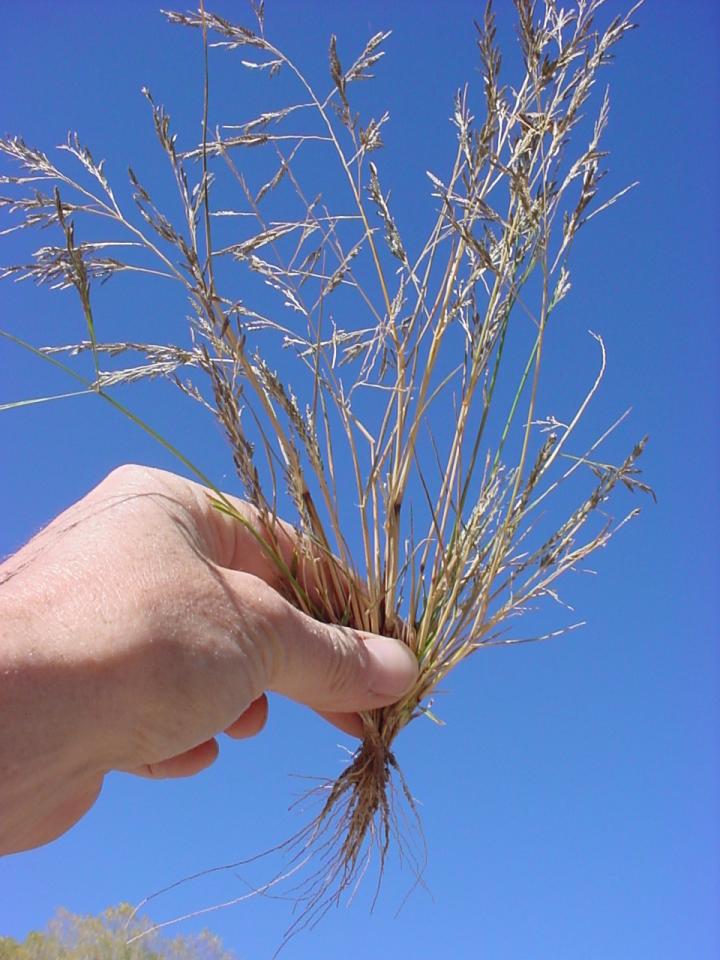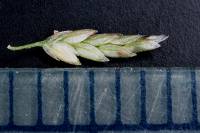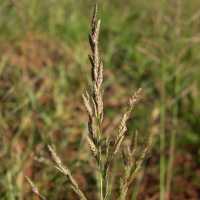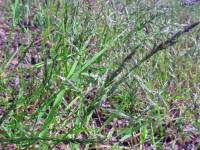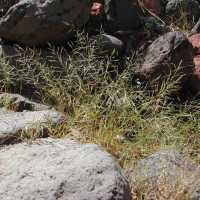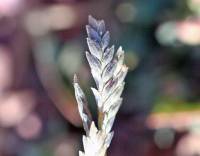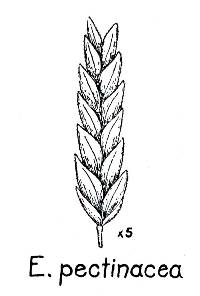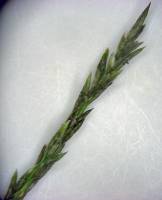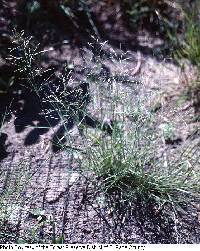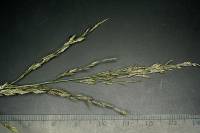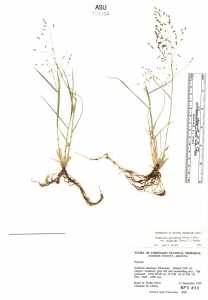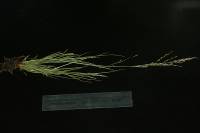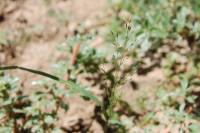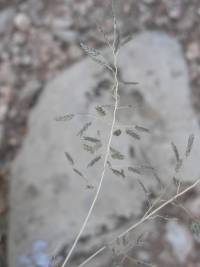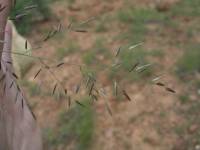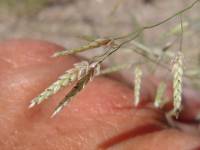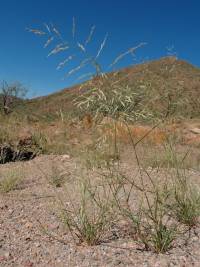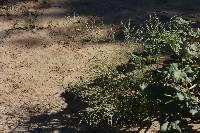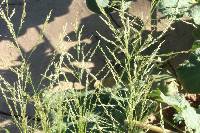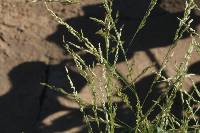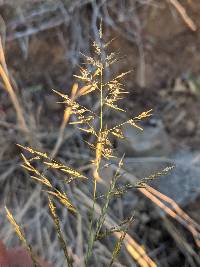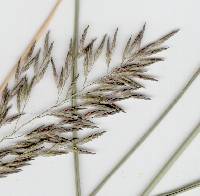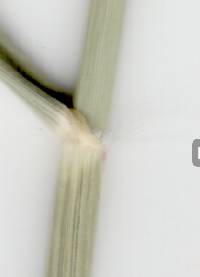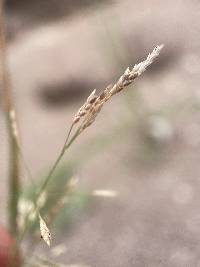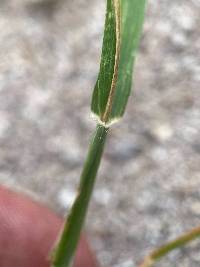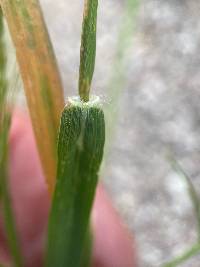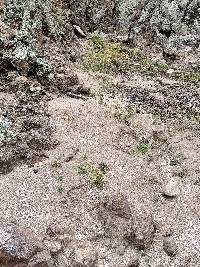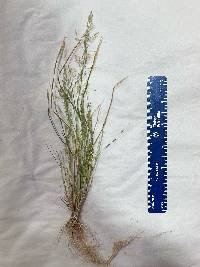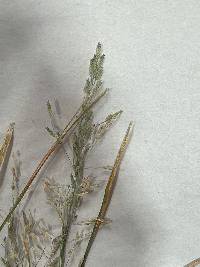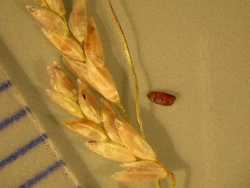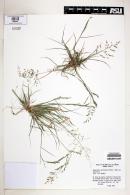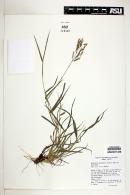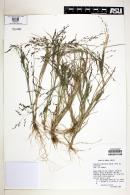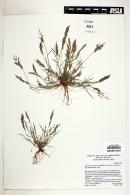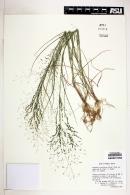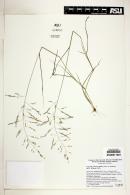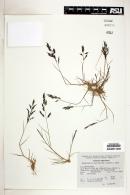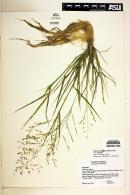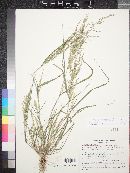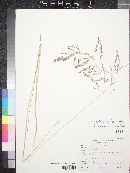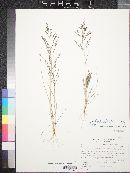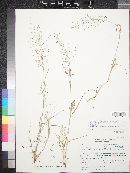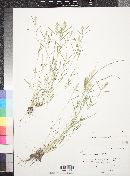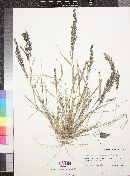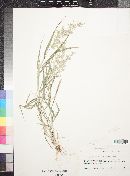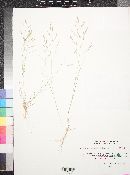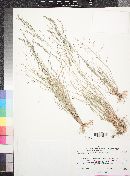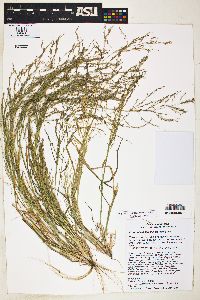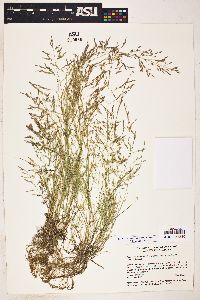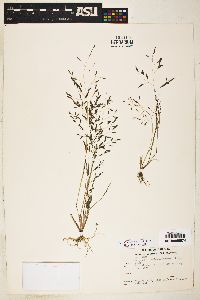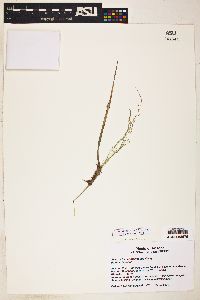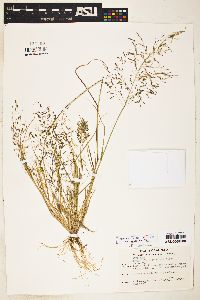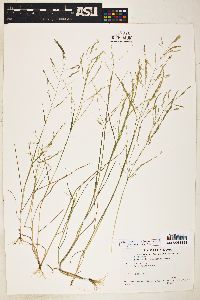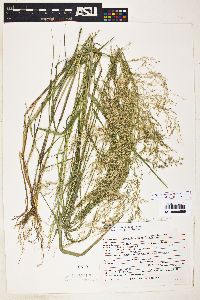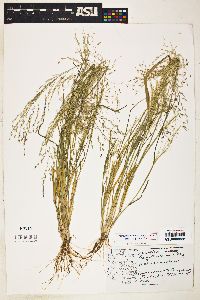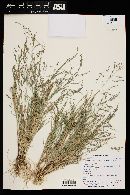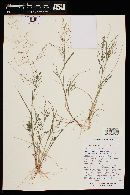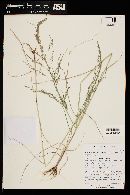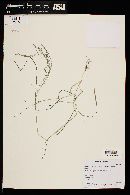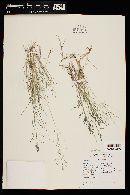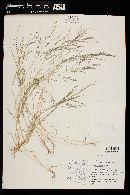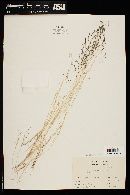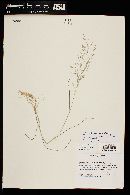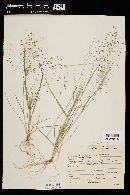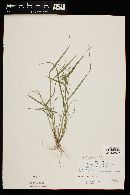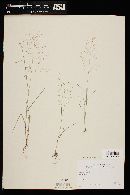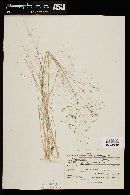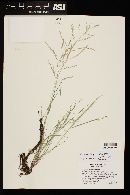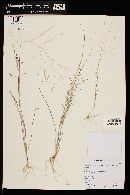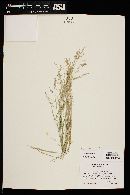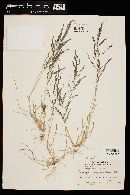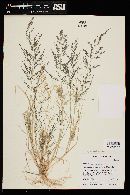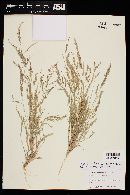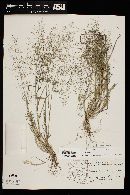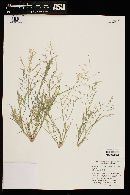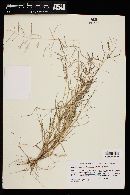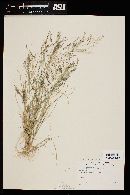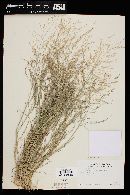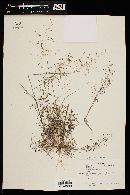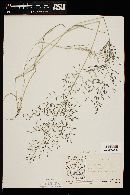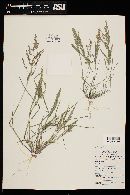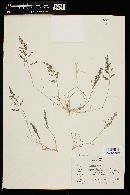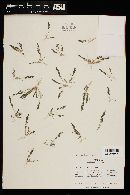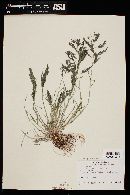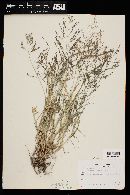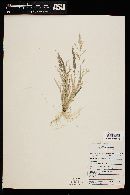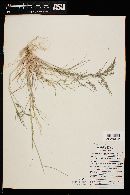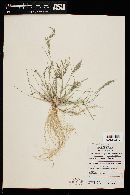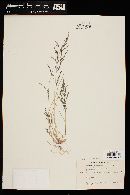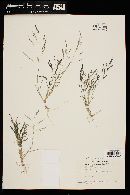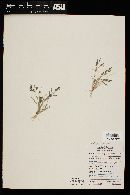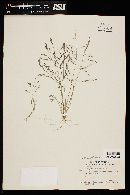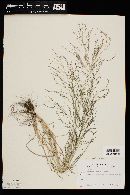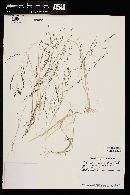Eragrostis pectinacea
|
|
|
|
Family: Poaceae
Purple Love Grass, more...lovegrass, purple lovegrass, spreading lovegrass, tufted lovegrass, Éragrostide Pectinée
[Eragrostis brizoides Schult., moreEragrostis cognata Steud., Eragrostis delicatula Trin., Eragrostis diffusa var. diffusa Buckley, Eragrostis nuttalliana Steud., Eragrostis pennsylvanica Scheele, Eragrostis pilosa var. caroliniana (Biehler) Farw., Eragrostis purshii var. delicatula Munro ex Scribn., Eragrostis purshii var. pauciflora E. Fourn., Eragrostis unionis , Poa diandra hort. ex Schrad.] |
Plants annual; tufted, without innovations, without glandular pits. Culms 10-80 cm, erect to geniculate or decumbent below, glabrous. Sheaths hirsute at the apices, hairs to 4 mm; ligules 0.2-0.5 mm; blades 2-20 cm long, 1-4.5 mm wide, flat to involute, abaxial surfaces glabrous and smooth, adaxial surfaces scabridulous. Panicles 5-25 cm long, 3-12(15) cm wide, ovoid to pyramidal, usually open, sometimes contracted; primary branches 0.6-8.5 cm, appressed or diverging to 80° from the rachises, solitary or paired at the lowest 2 nodes; pulvini glabrous or sparsely hairy; pedicels 1-7 mm, flexible, appressed to widely divergent, sometimes capillary. Spikelets 3.5-11 mm long, 1.2-2.5 mm wide, linear-oblong to narrowly lanceolate, plumbeous, yellowish-brown, or dark reddish-purple, with 6-22 florets; disarticulation acropetal, paleas persistent. Glumes subulate to ovate-lanceolate, hyaline; lower glumes 0.5-1.5 mm, at least 1/2 as long as the adjacent lemmas; upper glumes 1-1.7 mm, usually broader than the lower glumes; lemmas 1-2.2 mm, ovate-lanceolate, hyaline to membranous, grayish-green proximally, reddish-purple distally, lateral veins moderately conspicuous, apices acute; paleas 1-2 mm, hyaline to membranous, keels scabridulous, apices obtuse; anthers 3, 0.2-0.7 mm, purplish. Caryopses 0.5-1.1 mm, pyriform, slightly laterally compressed, smooth, faintly striate, brownish. 2n = 60. Eragrostis pectinacea is native from southern Canada to Argentina. In the Flora region, it grows in disturbed sites such as roadsides, railroad embankments, gardens, and cultivated fields, at 0-1200 m. Dr. David Bogler, USDA NRCS PLANTS Database Annuals, Terrestrial, not aquatic, Stems nodes swollen or bri ttle, Stems geniculate, decumbent, or lax, sometimes rooting at nodes, Stems caespitose, tufted, or clustered, Stems terete, round in cross section, or polygonal, Stem internodes solid or spongy, Stem internodes hollow, Stems with inflorescence less than 1 m tall, Stems, culms, or scapes exceeding basal leaves, Leaves mostly basal, below middle of stem, Leaves mostly cauline, Leaves sheathing at base, Leaf sheath mostly open, or loose, Leaf sheath hairy at summit, throat, or collar, Leaf sheath and blade differentiated, Leaf blades linear, Leaf blades very narrow or filiform, less than 2 mm wide, Leaf blades 2-10 mm wide, Leaf blades mostly flat, Leaf blade margins folded, involute, or conduplicate, Leaf blades mostly glabrous, Leaf blades scabrous, roughened, or wrinkled, Ligule present, Ligule a fringe of hairs, Inflorescence terminal, Inflorescence an open panicle, openly paniculate, branches spreading, Inflorescence a contracted panicle, narrowly paniculate, branches a ppressed or ascending, Inflorescence a dense slender spike-like panicle or raceme, branches contracted, Inflorescence solitary, with 1 spike, fascicle, glomerule, head, or cluster per stem or culm, Inflorescence branches more than 10 to numerous, Flowers bisexual, Spikelets pedicellate, Spikelets laterally compressed, Spikelet less than 3 mm wide, Spikelets with 3-7 florets, Spikelets with 8-40 florets, Spikelets solitary at rachis nodes, Spikelets all alike and fertille, Spikelets bisexual, Spikelets disarticulating above the glumes, glumes persistent, Spikelets disarticulating beneath or between the florets, Rachilla or pedicel glabrous, Glumes present, empty bracts, Glumes 2 clearly present, Glumes equal or subequal, Glumes distinctly unequal, Glumes shorter than adjacent lemma, Glumes 1 nerved, Lemmas thin, chartaceous, hyaline, cartilaginous, or membranous, Lemma similar in texture to glumes, Lemma 3 nerved, Lemma glabrous, Lemma apex acute or acuminate, Lemma awnless, Lemma margins thin, lying flat, Lemma straight, Palea present, well developed, Palea membranous, hyaline, Palea shorter than lemma, Palea 2 nerved or 2 keeled, Palea keels winged, scabrous, or ciliate, Stamens 3, Styles 2-fid, deeply 2-branched, Stigmas 2, Fruit - caryopsis, Caryopsis ellipsoid, longitudinally grooved, hilum long-linear.
Annual tufted herb, lacking glandular pits 10 cm - 1.05 m tall Leaves: with open sheaths that have stiff-haired (to 4 mm long) tips and ligules that are 0.2 - 0.5 mm long. The blades are 2 - 20 cm long, 1 - 4.5 mm wide, flat or with margins rolling toward the upper surface of the midvein (involute), hairless beneath and minutely rough above. Inflorescence: terminal, branched (panicle), usually open, rising above upper leaves, 5 - 25 cm long, 3 - 15 cm wide, egg-shaped to pyramidal, with 0.6 - 8.5 cm long primary branches that are solitary or paired on the lowest two nodes. Fruit: a brownish caryopsis, 0.5 - 1.1 mm long, pear-shaped, slightly compressed laterally, lightly lined longitudinally but not grooved. Culm: 10 cm - 0.8 m long, erect or sometimes with abrupt bends at the nodes (geniculate) or decumbent below, hairless. Spikelets: on a flexible stalk 1 - 7 mm long, lead-colored to yellowish brown or dark reddish purple, 3.5 - 11 mm long, 1.2 - 2.5 mm wide, linear-oblong to narrow lance-shaped, laterally compressed. Glumes: transparent, awl-shaped to narrow egg-shaped, single-veined, neither lobed nor awned, with the lower glume 0.5 - 1.5 mm long and the usually wider upper glume 1 - 1.7 mm long. Florets: six to 22 per spikelet, with three purplish anthers 0.2 - 0.7 mm long. Lemma: grayish green near the base and reddish purple near the tip, 1 - 2.2 mm long, narrow egg-shaped with a pointed tip, transparent to membranous, usually hairless, with somewhat conspicuous lateral veins. Palea: 1 - 2 mm long, transparent to membranous, with a blunt tip and two minutely rough longitudinal ridges. Similar species: Eragrostis cilianensis, Eragrostis frankii, Eragrostis minor, Eragrostis pectinacea, and Eragrostis pilosa are annuals that lack grooved caryopses (E. frankii sometimes has a shallow groove). All of these species except E. pectinacea may be glandular. Eragrostis cilianensis has wider (2 - 4 mm) and longer spikelets (6 - 20 mm), ten to 40 florets, and three yellow anthers. Eragrostis frankii is easily distinguished by its far fewer florets (three to six), E. minor has two reddish brown anthers, and E. pilosa has narrower (0.6 - 1.4 mm) spikelets and inflorescence branches that are usually whorled at the lowest two nodes. Flowering: late June to late September Habitat and ecology: Very common in cultivated and waste areas, parkways and parking lots, and cindery or sandy waste ground like railroad ballast. Occurence in the Chicago region: native Etymology: Eragrostis is derived from the name of the Greek god of love, Eros, and agrostis, meaning grass. Pectinacea means comb-like. Author: The Morton Arboretum FNA 2003, Gould 1980 Common Name: tufted lovegrass Duration: Annual Nativity: Native Lifeform: Graminoid General: Tufted annual grass with erect to geniculate stems, 10-80 cm, glabrous, branching at base and above. Vegetative: Sheaths hirsute at apices with hairs to 4 mm; collar pilose at margin; ligule a dense row of white hairs < 0.5 mm, truncate; blades 2-20 cm long, 1-5 mm wide, flat to involute, usually ascending, glabrous below, scabrous above. Inflorescence: Panicles ovoid to pyramidal, usually open, sometimes contracted, 5-20 cm long, 3-10 cm wide, rachis scabrous toward tip, branches slender, ascending to spreading, sometimes reflexed; primary branches appressed or diverging up to 80 degrees from rachis; spikelets 3-11 mm long, 1-3 mm wide, linear-oblong to narrowly lanceolate, yellowish-brown to dark reddish-purple, with 6-22 florets; glumes acute to acuminate, compressed, keeled, scabrous on tip of keel; lemmas ovate, acute, scabrous on keel, compressed, erose at tip, loosely imbricate. Ecology: Found in sandy soils of stream courses and in other disturbed soils; 4,500-6,000 ft (1372-1829 m).; flowers in summer to fall. Distribution: Native to the new world; Canada south across much of N America to S America; also in Europe, Middle East and Australia. Notes: Eragrostis species have branched inflorescences (panicles); multiple, bisexual flowers (florets) per spikelet; and components of the spikelets are for the most part hairless and awnless. This species distinguished by being an erect-ascending annual. Distinguished from the similar E. mexicana by a tuft of white hairs at the apex of the leaf sheath, where in E. mexicana there are often sparse hairs on the back of the sheath below the nodes as well. E. pectinacea also lacks a central groove in the seed (caryopsis). Different from E. cilianensis by the lack of glands on leaf sheath, the lack of a strong smell, and the much narrower spikelets. Ethnobotany: Unknown Etymology: Eragrostis is from Greek eros, love and agrostis, grass; pectinacea means comb-like. Synonyms: None Editor: SBuckley 2010, FSCoburn 2014, AHazelton 2015 Annual 1-6 dm, the culms erect or ascending, often repeatedly branched; lvs 1-4 mm wide; middle sheaths mostly shorter than their internodes; infl 5-25 cm, ovoid or pyramidal, diffusely branched with one or two branches at a node, or the lower branches rarely fascicled or whorled; pedicels appressed, rarely diverging as much as 20ڻ spikelets mostly 6-15-fld, 1.2-2.5 mm wide; first glume 0.5-1.1 mm, half to three-fourths as long as the lowest lemma; lemmas 1-2.2 mm, individually deciduous from the rachilla, on which the paleas persist; grain pyriform, slightly compressed, 0.5-1 mm; 2n=60. Moist ground, especially as a weed in gardens and waste places; widespread in our range, s. to C. Amer. and W.I. E. tephrosanthos Schult., a weed mainly of trop. S. Amer., occurs rarely and sporadically with us. It has spreading pedicels like E. frankii, but is otherwise more like E. pectinacea. Gleason, Henry A. & Cronquist, Arthur J. 1991. Manual of vascular plants of northeastern United States and adjacent Canada. lxxv + 910 pp. ©The New York Botanical Garden. All rights reserved. Used by permission. |
|
|
|

